

Problem and Solution for First Grade
- Read Alouds , Reading & Literacy
Being able to easily identify the problem and solution in a story is a foundational reading comprehension skill for first grade students.
It's an activity that can be done with every single read aloud.
It can (and should) be done whole group, in small group, with partners, in literacy stations and during independent reading.
It's also a great skill for parents to work on at home.
Describing the problem includes:
- Identifying the problem the character(s) is experiencing in the beginning of the story
- Asking questions and making predictions about possible upcoming events and about possible ways to solve the problem
- Understanding how the events and characters influence the problem throughout the story
Describing the solution includes:
- Confirming or revising predictions about the resolution
- Explaining how the resolution solves the problem
- Describing what happens to the character(s) because of the resolution
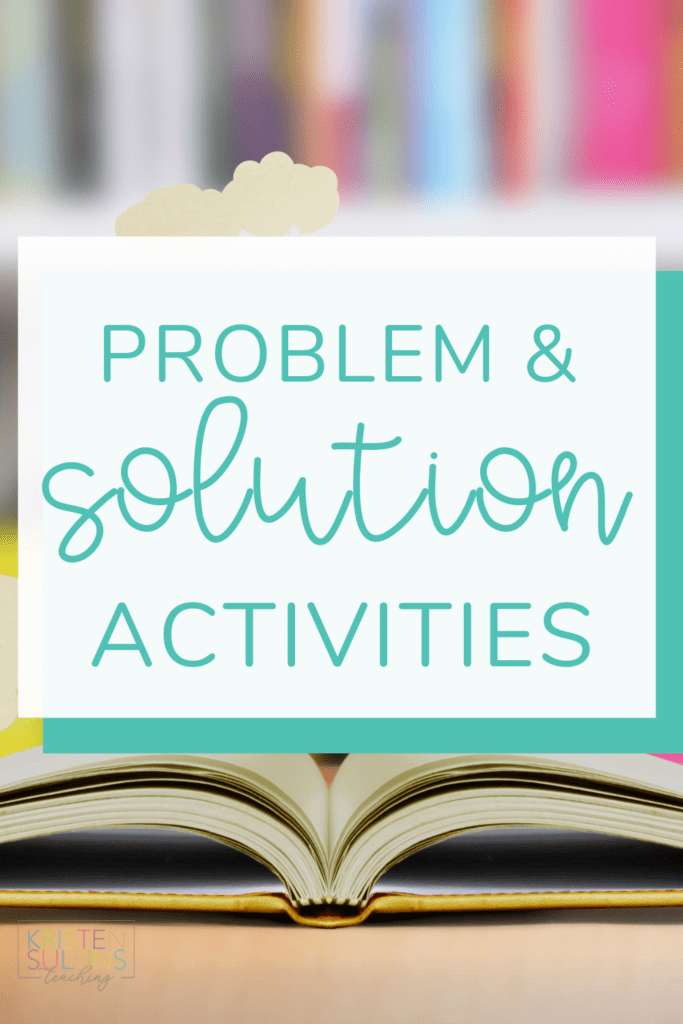
Examples of Problem and Solution
You might be totally comfortable with the topic of problem and solution, but when we are in the moment in front of 22 little faces, sometime we blank!
It's time to give our students examples of what Problem and Solution is…
but we've got nothing!
It helps to think of a few examples ahead of time and jot them down.
Examples of problem and solution work best if the are real life examples that the students can relate to!
Here's a few examples from the school day:
- Your pencil breaks
- You can't find your book
- You forgot your lunch
- You can't remember the directions
- You left your jacket on the playground
- You don't know how to tie your shoes
- You need a supply that another student is using
By using these real-life examples, you are not only teaching problem and solution, but you are reinforcing your classroom management as well!
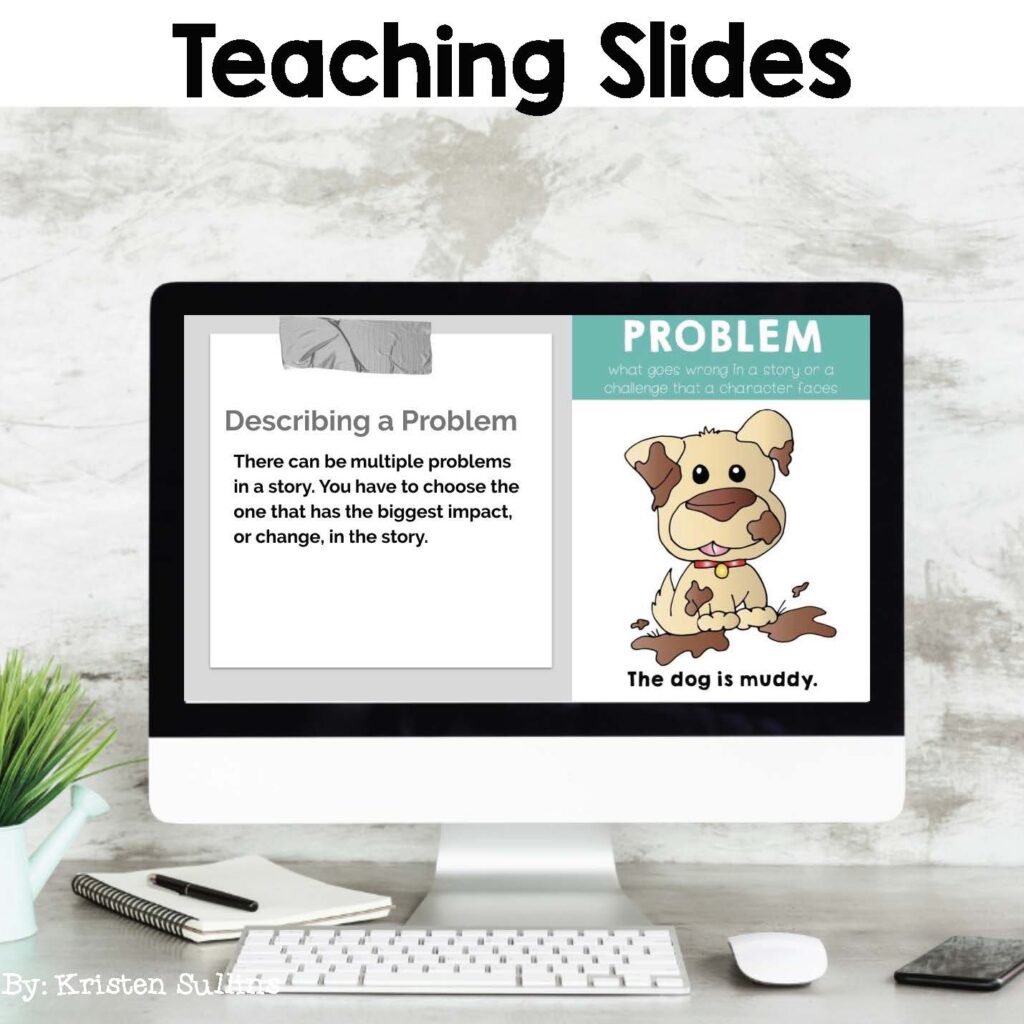
How to Introduce Problem and Solution for First Grade
If you teach lower elementary, then you know that there is SO much that goes into the comprehension of a book. First grade students are learning so much at this age and even listening comprehension requires their little brains to work so hard.
Why do I bring this up?
Because I want you to think about how hard they are ALREADY working when they are listening to a read aloud and when you use a mentor text to introduce a NEW SKILL, most students’ brains go into overload!
So what should we do instead?
Start with a non-text activity. Let me introduce you to a new kind of “slideshow”.
I like to use interactive slideshows/powerpoints. My slideshows always follow this order:
- Teaching Slides: Introduces students to WHAT the skill is
- Guided Practice: Introduces students to HOW to apply the skill
- Interactive Practice: Gives students an example and allows them to PRACTICE the skill in an easy and concise way
Problem and Solution Non-Text Activities for First Grade
After we practice the slideshow, then we practice building our problem and solution muscles with some guided and independent practice using a NON-TEXT ACTIVITY such as a station game.
Non-text activities are a HUGE asset to students because it allows them to build and flex their problem and solution muscles before we ask them to apply those skills to a text!
How to Complete the Activity
We will do this activity together as a group first, then it will move into our guided reading stations where students will complete it independently!
I've found the best and easiest way to do this is with images of problems/solutions that my first grade students know a lot about.
My students do this Problem and Solution activity (seen on the right). We do one together as a class for guided practice.
For this activity, students must correctly match the problem and solution. Then I have students write about the problem and solution with an emphasis on why the solution actually works for this problem.
After we do this activity together, it goes into their stations for Guided Reading.
The best part about this activity is that you can leave it out for several weeks because each time students can choose a new set of pictures!
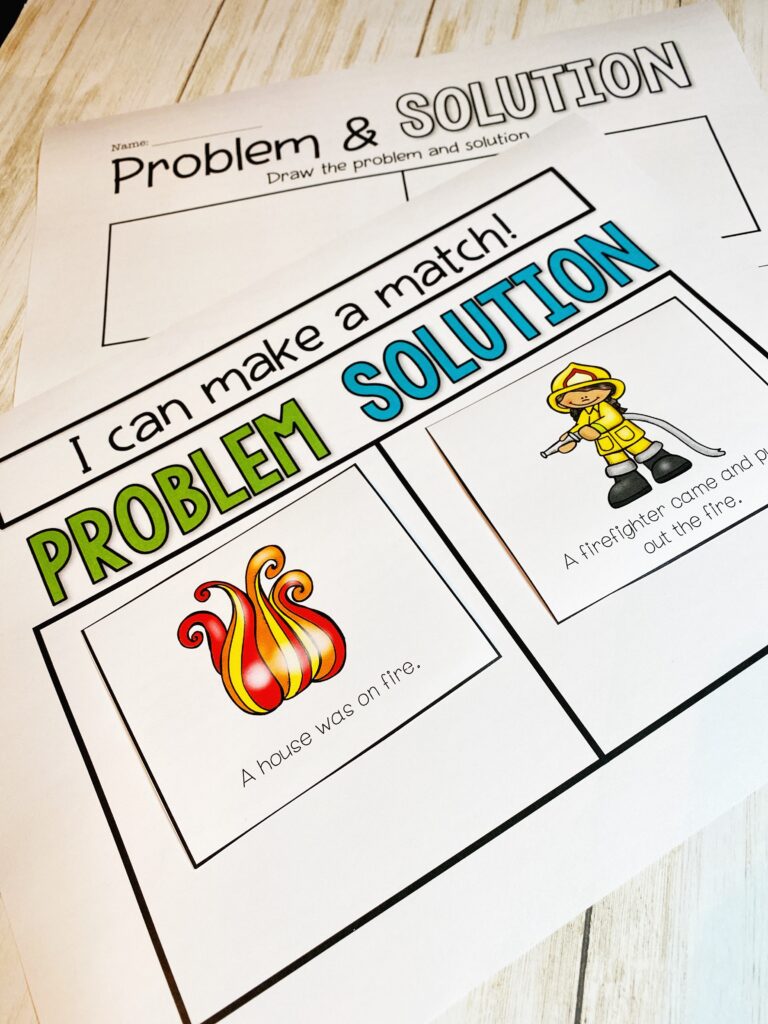
Mentor Texts for Problem and Solution
A mentor text is an incredibly powerful tool for teaching reading comprehension skills!
(make sure you keep reading to the end of this post to see a list of my favorite mentor texts for problem & solution)
The problem that many teachers run into with mentor texts is that there are SO MANY different skills you can teach with the same mentor text….
Sometimes we try to do TOO MUCH and we overwhelm our students!
Let me introduce you to a Comprehension Focus Question (CFQ).
A CFQ is one question that you focus on through the entire text!
It simplifies things for you and your students. (more on that later)…
But let's take a minute to dispel so myths about mentor texts..
A mentor text is NOT a book that you read once and put it away.
A mentor text is a book that you read once, then refer back to again and again and again.
The greatest benefit of a good mentor text is that after you have read it once, when you refer back to it, you aren’t reading the entire book again, you are simply referring back to one or two pages.
It will save you SO much time.
AND students are already familiar with the story line meaning that already have a foundation for whatever comprehension skill you are about to dive into!
How to Boost Comprehension for Problem & Solution
Comprehension Focus Questions
As I mentioned, a Comprehension Focus Question (CFQ) is a very focused and intentional comprehension goal for an activity, a week or even a unit.
If you have done your research and you understand your learning standard, the vocabulary and what students need to know…
Then it becomes very easy to choose a goal (or a comprehension focus question).
But, why do you need a comprehension goal?
To stay FOCUSED!
Not just for you, but for your students also!
Let’s look at an example. Let’s say that this week you are focusing on how to make an inference. Well, there are about a hundred different ways you can make an inference and a CFQ allows you to focus on one area at a time.
Example CFQ: “How Did The Character Change From ___ To ____?”
In this comprehension focus question, you and your students are focusing in on the characters of the story.
The great thing about CFQ’s is that the next time you pull out this mentor text, you can choose a different CFQ to focus on while still practicing how to make an inference!
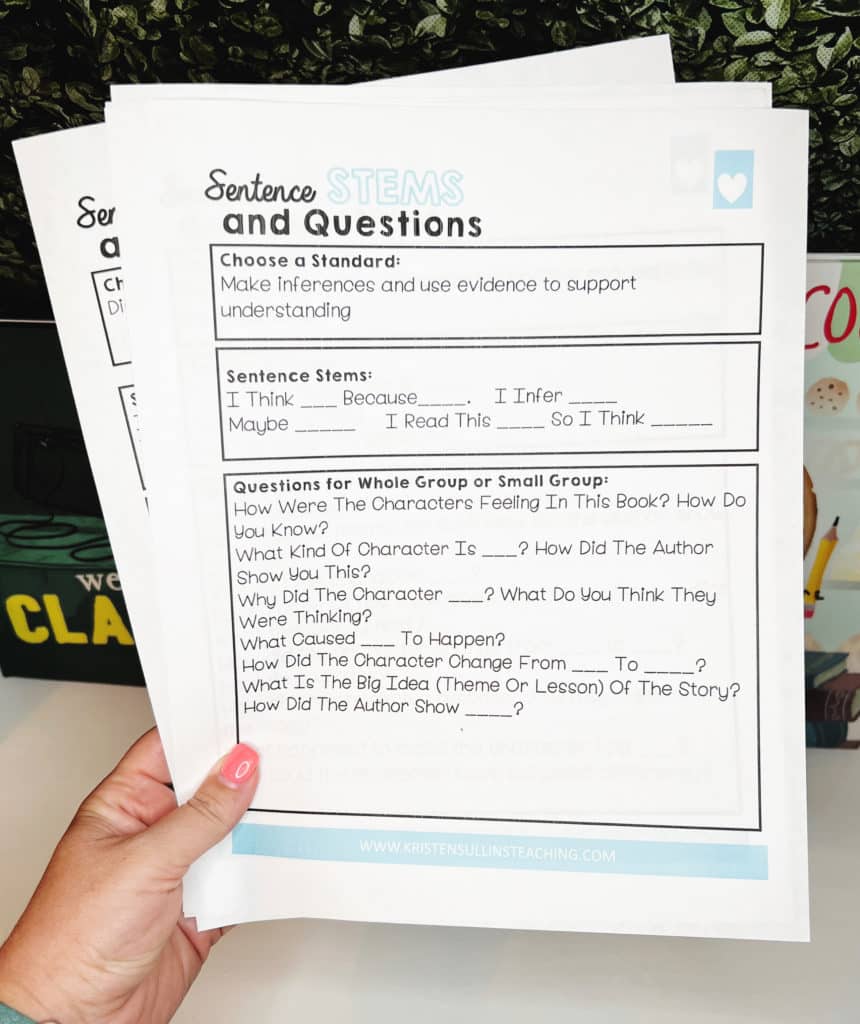
Sentence Stems
Another great strategy that falls right in long with mentor texts and comprehension focus questions is sentence stems.
A sentence stem is a phrase that your first grade students will use to answer a comprehension question.
Sentence stems are designed to get students to answer comprehension questions more fully rather than giving one word answers.
Sentence stems encourage students to explain their thinking.
I like to have a list of sentence stems next to my table that are specific to each comprehension skill. I stick to one or two stems per skill for the entire year because I want my students to be consistent. (This also makes it a lot easier for them)
If we are sticking with our Make an Inference example, I would use the following sentence stems:
I Think ___ Because____.
I Read This ____ So I Think _____
Problem and Solution Activities for First Grade
All of the activities that you found in this post, both printable and digital, along with UNIT LESSON PLANS can be found in my Problem and Solution Bundle here.
You can save up to 20% by purchasing the items together, but you can also purchase individual items to better fit your needs!
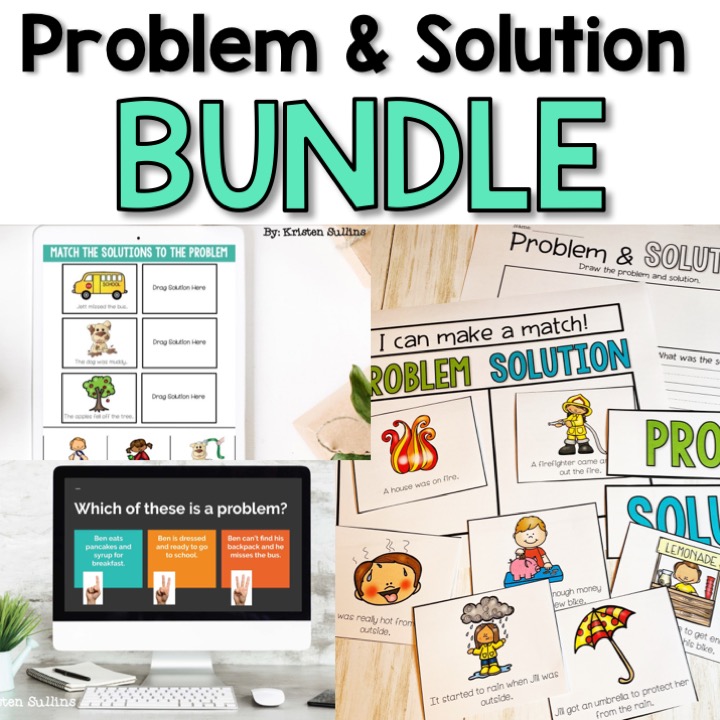
Best Books for Problem and Solution
**You can use the recording sheet from the Problem and Solution station with all of these read alouds!
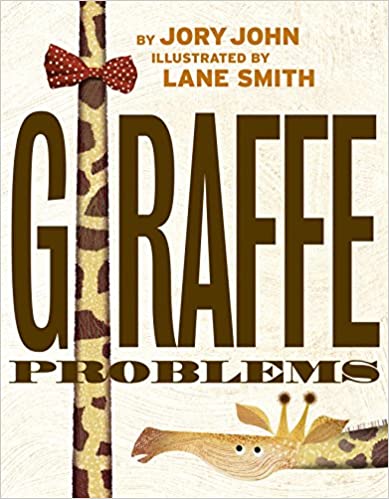
More First Grade Favorites
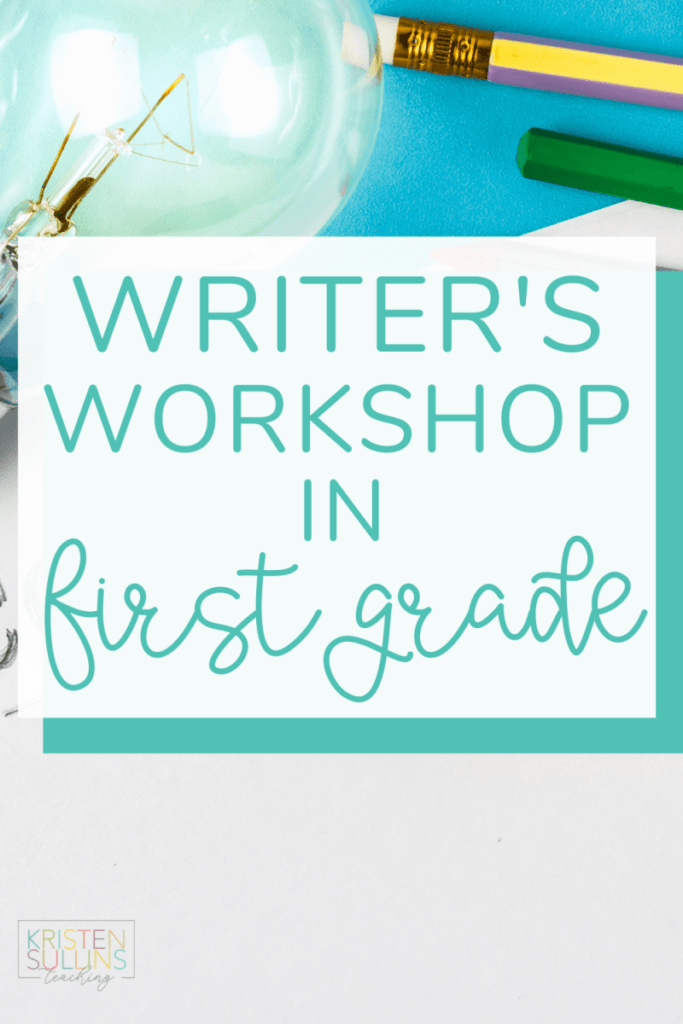
sign up for free stuff
Sign up to receive weekly emails with tips, free resources and info about upcoming sales.

Kristen Sullins
I am a current Elementary Librarian and Enrichment Teacher, mother of two, follower of Christ and Texas native. In my own classroom, I love to save time by finding unique ways to integrate writing, social studies and science into all parts of my day. I also love all things organization!
YOU MAY ALSO ENJOY...
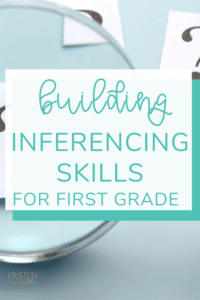
©2019 Kristen Sullins. All Rights Reserved
Site by Ashley Hughes
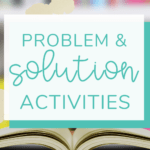

Solving Word Problems (Grades 1-2)
Our Solving Word Problems lesson plan provides students with strategies to help them solve word problems, such as using illustrations or drawings. Students practice solving example word problems using the given strategies.
Description
Additional information.
Our Solving Word Problems lesson plan develops math problem-solving strategies for young students. This interactive lesson equips students to identify and define keywords and use pictures or diagrams for math problem solving (addition and subtraction). Students are asked to work collaboratively, in pairs, to compose word problems that incorporate pictures or diagrams and exchange problems with other groups to solve. Students are also asked to individually complete practice problems in order to demonstrate their understanding of the lesson.
At the end of the lesson, students will be able to identify and define keywords and use pictures or diagrams for math problem solving (addition and subtraction).
State Educational Standards: LB.Math.Content.1.OA.A.2, LB.Math.Content.2.OA.A.1
Thank you for submitting a review!
Your input is very much appreciated. Share it with your friends so they can enjoy it too!
Great product
Love that it gives me a short lesson plan and the work to be done with it.
Solving Word Problems
This concept is hard for students. Thanks for explicit lesson on solving word problems.
We recently began homeschooling my son, after learning that he has not been being taught many subjects due to being in self-contained unit at school because of his behavioral issues. After explaining a few things to him, the material really helped to guide him on to the next part in our efforts to get him caught up. Thank you.
Related products

Picture and Sound Matching
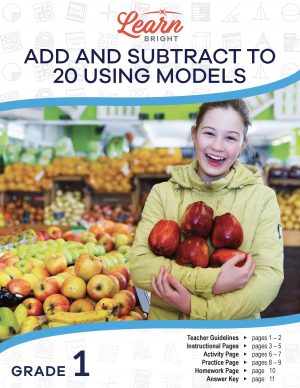
Add and Subtract to 20 Using Models

All about Butterflies

Numbers 10 to 20
Make your life easier with our lesson plans, stay up-to-date with new lessons.

- Lesson Plans
- For Teachers
© 2024 Learn Bright. All rights reserved. Terms and Conditions. Privacy Policy.
- Sign Up for Free
Word Problems (Grade 1)
Grade 1 Word Problems(examples, solutions, songs, videos, games, activities) Examples, solution, videos, and songs to help Grade 1 students learn how to use addition and subtraction within 20 to solve word problems involving situations of adding to, taking from, putting together, taking apart, and comparing, with unknowns in all positions, e.g., by using objects, drawings, and equations with a symbol for the unknown number to represent the problem.
Related Pages More Lessons for Grade 1 Common Core for Grade 1
Solve word problems that call for addition of three whole numbers whose sum is less than or equal to 20, e.g., by using objects, drawings, and equations with a symbol for the unknown number to represent the problem.
Common Core: 1.OA.1 and 1.OA.2
Suggested Learning Target
- I can model addition and subtraction word problems using objects, drawings, and equations with unknown numbers in different positions.
- I can solve addition and subtraction word problems using objects, drawings, and equations.
- I can solve word problems with unknown numbers in different positions (e.g., 6 + ? = 8, ? + 2 = 8, 6 + 2 = ?).
- I can represent a problem in multiple ways including drawings and or objects/manipulatives (e.g., counters, unifix cubes, Digi-Blocks, number lines)
- I can take apart and combine numbers in a wide variety of ways
- I can make sense of quantity and be able to compare numbers
- I can use flexible thinking strategies to develop the understanding of the traditional algorithms and their processes
- I can solve a variety of addition and subtraction word problems
- I can use _ or ? to represent an unknown in an equation
- I can add three whole numbers whose sum is less than or equal to 20.
- I can solve word problems with three whole numbers using objects, drawings, and equations.
- I can add numbers in any order and be able to identify the most efficient way to solve the problem
Addition Examples:
Result Unknown Two bunnies sat on the grass. Three more bunnies hopped there. How many bunnies are on the grass now? 2 + 3 = ?
Change Unknown Two bunnies were sitting on the grass. Some more bunnies hopped there. Then there were five bunnies. How many bunnies hopped over to the first? 2 + ? = 5
Start Unknown Some bunnies were sitting on the grass. Three more bunnies hopped there. Then there were five bunnies. How many bunnies were on the grass before? ? + 3 = 5
Subtraction Examples:
Result Unknown Five apples were on the table. I ate two apples. How many apples are on the table now? 5 – 2 = ?
Change Unknown Five apples were on the table. I ate some apples. Then there were three apples. How many apples did I eat? 5 – ? = 3
Start Unknown Some apples were on the table. I ate two apples. Then there were three apples. How many apples were on the table before? ? – 2 = 3
Word Problems. Addition with pictures (up to sum 20) Example: Lily had 5 apples and her aunt gave her 9 apples later. How many apples did Lily have finally?
Subtraction by counting back - word problems with pictures Example: There are 5 books on the desk. Betty took 2 away. How many books are left on the desk?
Word problems - subtraction with pictures - cross out - 1 digit Example: There are 9 cars in the shop and 8 of them are sold. How many cars are left?
Word problems - Subtraction with pictures - cross out (numbers to 20) Example: Mary had 11 toys and she gave 5 of them to Emma. How many toys did Mary have finally?
Word problems - adding multiple one-digit numbers Example: A furniture store sold 6 tables, 2 bookcases and 1 bed. How many pieces of furniture did the store sell in all?
Addition word problems that add up multiple values to sums less than or equal to ten. Example:
Laurem gave Troy two yellow pencils, three blue pencils and one green pencil. How many pencils did Lauren give him in all?
Ms. Ellis gave Lauren and Troy some cookies. Lauren ate two sugar and two chocolate chip cookies. Troy ate three oatmeal raisin and two sugar cookies. How many cookies did they eat in all?
Subtraction Strategies This video gives suggestions for solving subtraction story problems using a math mountain, equation, and circle drawing. Example: I have 8 peanuts. Then I eat 5 of them. How many peanuts are left?

We welcome your feedback, comments and questions about this site or page. Please submit your feedback or enquiries via our Feedback page.

Want to create or adapt books like this? Learn more about how Pressbooks supports open publishing practices.
79 Problem-Based Lesson Plan Template
Problem-based lesson plan template.
For additional information on Problem-based instruction, please visit our Teaching Strategies page of the MNSU Instructional Design Services . In order to implement a problem-based instruction lesson in your classroom, there are a few planning steps to consider. Fill in the blanks with your lesson-specific information in order to plan your problem-based lesson.
1. Develop clear and measurable learning objectives (including cognitive and behavioral objectives) – based on Bloom’s Taxonomy
- Students will be able to {verb} {noun}.
Ex: Students will demonstrate the methods of organismal biologists, including observation, phylogenetics, experimentation, and form/function studies.
2. Identify the learning resources students will need to access at home before coming to class. These resources are generally what you would normally do in a traditional lecture format class (lecture, videos, etc)
- Reading materials
- Watch instructional video xxx (name of the video) for xx minutes http://www …
- Exercise on worksheets, if any
- Suggest other learning resources
Ex: Before class on Thursday, please watch instructional video #1.
Learning Resources my lesson will include:
- __________________________________
Technology Resources I will need to create the pre-class learning resources:
3. Prepare the real-world, contextual problem that students will use to explore the content. You can either create a problem or select one from an existing problem bank. Follow the guidelines below for both selecting and creating a problem.
Garner’s (2010) suggested PBL problem elements:
- The topic of concern captures the attention and interest of participating students.
- Students are required to make judgments and decisions by analyzing a variety of options in choosing their best course of action.
- The proposed problem has a level of complexity that involves all team members in the data gathering and decision-making phases.
- Questions are open-ended and invite group members to participate.
- There is a direct connection between the PBL scenario and course learning outcomes.
Students should be able to answer the following four questions when working towards a problem solution:
- What do I know (about the problem or issue)
- What do I need to know to solve it?
- How do I get that information?
- How do I apply that information to determine a solution?
You can also use created problems from resources like the University of Delaware’s PBL Clearninghouse
My problem:
Ex: (From A Principles of Organismal Biology course)
200,000 people applied to be a part of the Mars colonization project. The 40 candidates that were selected have asked you, a biologist, to describe for them what plant or animal life might exist on Mars or what life might exist on Mars eventually through colonization, adaptation, and mutation. Based on your knowledge of Earth biology, what might a Mars plant or animal look like? How could you prepare the colonist for creatures or life they might encounter?
4. Define the procedures for in-Class problem analysis that your students will be completing. Let students know if they need to bring or prepare anything before class. The idea is to create an active learning environment where students interact with the content and the instructor acts as a guide. Activities should scaffold the students into the problem solution.
- Establish ground rules for participation
- Assign discussion groups or roles in the problem-solving process
- Students define facts and significant information surrounding the problem
- Pose challenging questions to further discussion
- Students define objectives and possible solutions
Activities students will complete analyzing the problem:
Technology Resources my students will need to complete the analysis:
Ex: Create a graphic organizer of your choice (graphic, infographic, flyer, blog, etc) that illustrates the lineages of life. Categorize them by one of the following: their biodiversity, anatomy, physiology, development, behavior, biogeography, fossil record, or ecology. Then hypothesize how the lineage might be extended to include extraterrestrial life and add those branches to your organizer.
5. Identify any post-analysis activities that your students will be completing.
- Shift context – students see problem or solution from another point of view
- Follow up discussion
- Shift time frame – “what’s next?”, “How could this situation be different?”
Activities students will complete post-analysis:
Technology Resources my students will need to complete the post-analysis activities:
Ex: Write a counterargument to your problem solution. Take the side of those who might not agree with your conclusions. What alternatives or arguments against your theories exist?
- Create the assessments that you will use for determining students’ mastery of the learning objectives.
- Formative/Summative
- Challenging questions
- Interactive quizzes
- Problem solution presentations
Ex: Using what you have learned in this class, present and describe a lifeform colonist might encounter in the Martian environment. Visuals, such as a drawing, would be useful to help the colonists identify possible lifeforms. Use the scientific method to present your lifeform hypothesis.
Assessment(s) I will use in my problem-based lesson:
Technology Resources my students will need to complete the assessment(s):
7. Verify that your assessments and activities align to the learning objectives. Do they allow your students to demonstrate that they have achieved the learning objectives?
Maverick Learning and Educational Applied Research Nexus Copyright © 2021 by Minnesota State University, Mankato is licensed under a Creative Commons Attribution-NonCommercial 4.0 International License , except where otherwise noted.
Share This Book

Reading & Math for K-5
- Kindergarten
- Learning numbers
- Comparing numbers
- Place Value
- Roman numerals
- Subtraction
- Multiplication
- Order of operations
- Drills & practice
- Measurement
- Factoring & prime factors
- Proportions
- Shape & geometry
- Data & graphing
- Word problems
- Children's stories
- Leveled Stories
- Context clues
- Cause & effect
- Compare & contrast
- Fact vs. fiction
- Fact vs. opinion
- Main idea & details
- Story elements
- Conclusions & inferences
- Sounds & phonics
- Words & vocabulary
- Reading comprehension
- Early writing
- Numbers & counting
- Simple math
- Social skills
- Other activities
- Dolch sight words
- Fry sight words
- Multiple meaning words
- Prefixes & suffixes
- Vocabulary cards
- Other parts of speech
- Punctuation
- Capitalization
- Narrative writing
- Opinion writing
- Informative writing
- Cursive alphabet
- Cursive letters
- Cursive letter joins
- Cursive words
- Cursive sentences
- Cursive passages
- Grammar & Writing
Breadcrumbs
- Word Problems
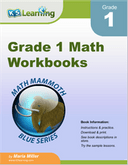
Download & Print From only $3.60
1st Grade Math Word Problems Worksheets
Grade 1 word problems.
These grade 1 word problem worksheets relate first grade math concepts to the real world. The word problems cover addition, subtraction, time, money, fractions and lengths.
We encourage students to think about the problems carefully by:
- providing a number of mixed word problem worksheets;
- sometimes including irrelevant data within word problems.
Addition word problems
Single digit addition
Addition with sums 50 or less
3 or more numbers added together
Subtraction word problems
Subtracting single digit numbers
Subtracting numbers under 50
Mixed addition and subtraction word problems
Add / subtract word problems with mostly single digit numbers
Add / subtract word problems with numbers under 50
Time word problems
Time and elapsed time problems (whole hours)
Money word problems
Counting money (coins only)
Measurement word problems
Combining and comparing lengths (inches)
Combining and comparing lengths (cm)
Fraction word problems
Write the fraction from the story (parts of whole, parts of group)
Mixed word problems
Addition, subtraction, money, time, fractions and length word problems mixed

Sample Grade 1 Word Problem Worksheet
Your cookie preferences
In order to provide you with the best possible experience on the LifeSkills website we use cookies and similar technology to collect data from your device and browser while you are here. Collecting this data helps us to personalise content for you, understand how you use the website, allow access to social media features and deliver personalised service and advert message content. You can find out more in our Cookie Policy . Please select ‘Accept all’ to consent to us collecting your data in this way. To see other data collection options, select ‘Manage data preferences’.
The types of similar technologies used in this website fall into one of four categories - Strictly Necessary, Performance, Functionality & Profile and Targeting. You can find out more information in our Cookie Policy .
Please indicate the categories you wish to consent to by selecting ‘Manage data preferences’ and using the sliders below and then click “Save preferences” to retain your preferences for future visits. You can change these preferences at any time by clicking Cookie Policy on our website.
Strictly necessary
Data collected in this category is essential to provide our services to you. The data is necessary for the website to operate and to maintain your security and privacy while using the website. Data is not used for marketing purposes or for the purposes covered by the other three categories below. This category can’t be disabled.
Performance
These help us improve the experience for all users of the website. Data collected in this category is to inform us how the website is used, improve how our website works and to help us to identify issues you may have when using our website. This data is not used to target you with online advertising.
Data collected in this category is used to help make our messages more relevant to you. The data is shared with other third parties, such as advertisers and platforms we may use to deliver personalised advertisements and messages. If you don’t wish to consent to this category, it’s important to note that you may still receive generic advertising or service messages, but they will be less relevant to you
Functionality & Profile
Data collected in this category enables the website to remember choices you make. This means a more personalised experience for features of the website that can be customised. It may also be used to provide services you've asked for, such as watching a video or commenting on a blog.
For learners from school through to university and beyond
What stage are you at?
For people like teachers, youth group leaders, mentors, local authorities, charities, job centre staff, and parents or carers
Work with a group or a class
Coach an adult
Tools, tips and activities to help your family
Resources for educators
- Login Sign up for free
Save to a group
Would you like to create a subgroup to help organise your saved items?
- I'm here to help others
- Lesson plans
Problem solving
Problem solving lesson plan

Time to complete
Download the full lesson plan pack including all related resources
Choose to download one or more individual resources
Problem Solving: Lesson plan
Problem solving: Presentation slides
Demonstrating your skills quick fire activity
Problem solving in practice: Interactive worksheet
Our problem solving content focuses on one of these skills and develops understanding of the six stages of problem solving, as well as identifying different types of situations in which young people might already be using these skills. Furthermore, it encourages them to use an adaptive approach, explaining that different types of problems can be approached in different ways.
The activities on this page support your teaching of these skills through an independent activity, quick activities or a full length, curriculum-linked lesson plan.
Teaching resources:
- Problem solving: Lesson plan and presentation slides – full lesson plan including icebreaker for use with a group of students in the classroom
- Demonstrating your skills: Quick-fire activity – 10 minute activity for a group of students in the classroom, can be used as an icebreaker for the lesson plan
- Problem solving in practice: Interactive worksheet – activity for independent learning whether remote or in class
Lesson plan
(60 -75 minutes)
This lesson is designed to equip young people with an adaptable approach to solving problems, large or small. It includes a short film and scenarios that encourage development of practical problem solving skills which can be useful for learning, day to day life, and when in employment.
By the end of the lesson, students will be able to:
- Identify problems of different scales and what is needed to solve them
- Illustrate the use of an adaptable approach to solving problems
- Understand that problem solving is a core transferable skill and identify its usefulness in a work setting
- Work on a problem solving activity in a team
The lesson aims to reinforce students’ understanding of the potential future applications of this skill as they move into the world of work, particularly in an activity differentiated for an older or more able group on creating new opportunities.
Quick-fire activity
(5 - 10 minutes)
The demonstrating your skills quick-fire activity focuses on helping young people understand the key skills that are needed in the workplace, including the importance of problem solving.
Students will be asked to name the skills being demonstrated in a variety of scenarios, and identify ways they’re already using those skills in this short activity.
You might find it useful as a starter or icebreaker activity to begin a lesson, or at the end to allow students to put what they have just learnt in the Problem solving lesson into practice.
Interactive worksheet
(20 - 25 minutes)
Please note that students below the age of 14 cannot sign up for their own LifeSkills account. Any independent tasks must be printed or downloaded and provided digitally for them to complete as they are currently hosted on educator pages.
The Problem solving in practice interactive worksheet introduces some of the themes from the full lesson plan and gives students some practical strategies for problem solving, including introducing the six stages of problem solving. The worksheet can be printed or completed digitally, so can be used flexibly to give students practise putting their problem solving skills into action. You might choose to assign it:
- As homework following the Problem solving lesson
- For independent study
- For remote learning
Looking for more ways to boost self confidence with LifeSkills?
Other lessons that may prove useful for students to build on these activities include the Adaptability and Innovation and idea generation lessons. Alternatively, consider encouraging them to apply their skills through Steps to starting a business or the Social action toolkit .
Why not build problem solving in as a focus in your students’ wider curriculum? Refer to our Content guide to find out how this resources can be used as part of your teaching.
Curriculum tags
A free account gives you access to all educator content, tools and resources
Already have an account, get started, thank you for liking.
Help us to continue creating relevant content for you by leaving some additional feedback .
Additional feedback
All feedback will be anonymous and will help us to provide more effective content for you and your student.
Thank you for letting us know what you thought of .
Why not try one of these next?

Staying positive (resilience)
Staying positive and learning through experience are key to succeeding in challenging situations. Try this lesson and help your students succeed at work.

Good leadership styles and effective teamwork can help students excel in their future workplace. Read more about team leader skills in this lesson.

Social action toolkit
Build a comprehensive social action programme and support young people to access enriching experiences that build transferable skills for work.
- Administrator
- Teacher How To's
- How It works
- All Worksheets
- Math Worksheets
- ELA Worksheets
1st Grade Lesson Plans
Dive into our interactive lesson plans for 1st graders! Find engaging math and ELA lessons on key concepts, such as addition and subtraction strategies, comparing measurements, telling time, reading, writing, sight words, and more. Our curriculum-aligned lesson plans for first grade teachers offer fun t ... Read more asks, learning objectives, simple notes for teachers, and tips to address common misconceptions. Preferred by millions of educators for 1st-grade instruction! Ready to explore? Start now for free!

CONTENT TYPE
- Lesson Plans
- Number Sense (3)
- Counting (1)
- Compare and Order Numbers (3)
- Addition (15)
- Subtraction (11)
- Measurement (1)
- Counting Money (4)
- Word Problems (7)
- Reading (32)
- Phonics (13)
- Books and Genres (1)
- Reading Skills (15)
- Communication Skills (5)
- Writing (3)
- Creative Writing (3)
- Grammar (10)
- Adverbs and Adjectives (1)
- Nouns and Pronouns (3)
- Prepositions and Conjunctions (2)
- Punctuation (1)
- Sentences (1)
- Verbs and Tenses (1)
- Vocabulary (6)
- Affixes (2)
- Making Connections in Reading (2)
Number Sense Lesson Plans

Embrace Place Value Basics: Fun Learning Ahead Lesson Plan
Explore place value with this interactive math lesson. Learn to count in groups of 10, understand the relationship between rods and unit blocks, and compare quantities of tens and ones.

Count & Add: Explore 10-Frames Lesson Plan
Engage in counting and addition activities with this interactive math lesson.

2-Digit Place Value Adventure Lesson Plan
Discover the magic of place value as you explore the world of 2-digit numbers. Engage in interactive tasks and gain a deep understanding of tens and ones, comparing numbers, and representing them in various ways.
Addition Lesson Plans

Place Value Quest: More, Less & Beyond Lesson Plan
Explore the concept of more and less in this interactive math lesson. Students will develop a solid understanding of place value and learn to find one more or one less than a given number within 100.

Multiple of 10 Arithmetic: Exciting Math Voyage Lesson Plan
Master adding and subtracting multiples of 10 with this interactive math lesson. Explore misconceptions, engage in hands-on activities, and reinforce understanding through a variety of tasks.

Thrilling Journey: Adding & Subtracting 10’s Lesson Plan
Master adding and subtracting multiples of 10 with this engaging math lesson.

Conquer 2-Digit & 1-Digit Number Summation Lesson Plan
Join us on an exciting adventure as we explore the world of addition by adding a 2-digit number and a 1-digit number. Engage in fun activities and games to strengthen your skills!
Subtraction Lesson Plans

Bar Models: Mastering Comparison Word Problems Lesson Plan
Master comparison word problems with sets and bar models!

Number Lines: Mastering Addition & Subtraction Lesson Plan
Develop counting on and counting back skills using number lines in this interactive math lesson.

Dive into Subtraction Methods Lesson Plan
Master subtraction with this interactive math adventure!

Master Subtraction Word Problems Lesson Plan
Master subtraction word problems with this fun-filled math adventure!
Measurement Lesson Plans

Hands-On Measurement of Length Lesson Plan
Embark on a math adventure as you explore the concept of length and measurement. Engage in exciting tasks that help you compare lengths, order objects by size, and measure accurately using reference objects.
Time Lesson Plans

Dive into Time's Mysteries Lesson Plan
Explore the concept of time through engaging activities and analog clocks. Learn about different parts of the day, recognize hour and minute hands, and understand the difference between hours and minutes.
Money Lesson Plans

Money Matters: Dive into Coin Adventures Lesson Plan
Explore the world of bills and coins in this interactive lesson. Learn to identify different denominations, count money, and understand their values.

Coin Magic: Identify & Count Dimes and Quarters Lesson Plan
Explore the world of dimes and quarters in this interactive math lesson!

Unlocking Money Power Interactive Lesson Lesson Plan
Explore the world of money in this interactive lesson. Understand different forms of currency, count coins, and learn about the value of saving.

Dive into Money World Lesson Plan
Explore coins and bills in this interactive lesson. Learn to identify, compare, and count money while discovering the value of different coins and bills.
Word Problems Lesson Plans

3-Number Summation: An Epic Math Adventure Lesson Plan
Master addition skills with this interactive math lesson. Learn how to add three numbers using various strategies and solve word problems along the way!

Addition Word Problems Adventure Lesson Plan
Unleash your problem-solving skills with this interactive math lesson on addition word problems. Solve mysteries while mastering the count on strategy!

Addition & Subtraction Problems Magic Lesson Plan
Master addition and subtraction word problems with our interactive math lesson. Join the Word Problem Wizards on a magical journey of learning!

Tackle Real-World Addition Word Problems & Win Lesson Plan
Solve addition word problems with ease!

Reading Lesson Plans

Solving Mysteries: An Interactive Puzzle Adventure Lesson Plan
An engaging lesson plan combining puzzles and mysteries.

Opinion Formation Odyssey Lesson Plan
Learn to form and express opinions with our interactive lesson plan.

Poetry Club Sparkle: An Interactive Learning Experience Lesson Plan
Explore the magic of poetry with our interactive lesson plan.

Vowel Voyage Long U Sound Lesson Plan
Explore the long u sound in this interactive lesson plan!
Writing Lesson Plans

Book Builders: How-To Writing Lesson Plan
Learn to write a how-to book in this interactive lesson!

Invitation Innovation Lesson Plan
Learn to design an engaging birthday invitation in this interactive lesson.
Grammar Lesson Plans

Noun Navigators Lesson Plan
An engaging lesson plan to master the world of nouns.

Adjective Artistry Grammar Lesson Plan
Discover the world of adjectives through engaging activities and games!

Conjunction Junction Function Lesson Plan
An engaging lesson plan that introduces and reinforces the concept of conjunctions.

Punctuation Prowess Lesson Plan
Learn the art of punctuation through an engaging story about Fixotron, the dinosaur.
Vocabulary Lesson Plans

Superheroes of Grammar: An Interactive Word Changers Lesson Plan
Discover the magic of word changers in this engaging grammar lesson.

Real-Life Connections with Words Lesson Plan
Learn to connect words with real-life experiences in this engaging lesson.

Decoding Words with Detective DSouza Lesson Plan
Uncover the mystery of word meanings with context clues and affixes.

Building Connections: An Interactive Learning Adventure Lesson Plan
An engaging lesson plan that teaches students how to build connections with texts.
All Lesson Plans Lesson Plans

Determiners Decoded Lesson Plan
An engaging lesson plan focusing on mastering determiners in grammar.

Categorization Conquerors Lesson Plan
An engaging lesson plan focusing on mastering categorization through interactive activities.

Vowel Voyage: An Interactive Learning Journey Lesson Plan
An exciting voyage into the world of vowels and their sounds.

Shades of Meaning - Adjectives and Verbs Lesson Plan
Explore the fascinating world of words and their varying meanings in this interactive lesson.

Addition & Subtraction Connection Lesson Plan
Explore the connection between addition and subtraction in this interactive math lesson.

Vowel Voyage Long I & O Sound Lesson Plan
Explore the world of long 'i' and 'o' sounds in this engaging, interactive lesson.

Solve Subtraction Word Problems Lesson Plan
Solve subtraction word problems with confidence!

Blend It Like R: An Interactive R-Blends Mastery Lesson Plan
Learn to read and spell words with R-blends in this interactive lesson.

Balancing Nouns & Verbs Lesson Plan
Learn and practice noun-verb balance in an engaging way!

Subtraction 'Take from 10' Adventure Lesson Plan
Master subtraction with the 'Take from 10' strategy in this interactive math lesson.

Friends from Alphabetland: A Digraphs Discovery Lesson Plan
Explore the world of digraphs with our engaging 'Friends from Alphabetland' lesson plan.

Pronouns Power Play Lesson Plan
Dive into the world of pronouns with our interactive lesson plan.

Number Representations Magic Lesson Plan
Explore number representations in a fun and interactive way!

Words by Heart: A Spelling Mastery Expedition Lesson Plan
An interactive lesson plan to master spelling of high-frequency words.

Thrilling Addition: Count On & Count Back Fun Lesson Plan
Master addition within 10 using counting on and counting back strategies in this interactive math lesson.

Blending Sounds with L's Blenderania Lesson Plan
An engaging lesson on mastering L-blend words.

Prepositions in Practice: An Interactive Learning Expedition Lesson Plan
Embark on a fun-filled journey of mastering prepositions with Leafel and Buc-Buc!

Double-Up: Addition Strategy Lesson Plan
Master addition using the doubles strategy! Engage students with interactive activities and visual aids to enhance their understanding.

High Frequency Words Wizardry Lesson Plan
An exciting journey with Lookie and Roboko to master high-frequency words.

Sight Words Spectacle: An Interactive Learning Journey Lesson Plan
An engaging lesson plan focused on mastering sight words through interactive tasks.
Browse Our Fun Collection of Lesson Plans for 1st Grade!
We are happy to introduce our creative collection of grade 1 lesson plans, designed to make teaching math and ELA both enjoyable and effective. These lessons are crafted to support teachers in their crucial role of educating and shaping young minds.
Our teacher-friendly lesson plans align perfectly with the common core standards. Grade 1 is an important step in elementary education for children aged about 6 to 7 years, where kids learn several important concepts in math and ELA .
- Math Lesson Plans for 1st Graders: With our 1st grade math lesson plans, students learn number sequences, counting , comparing and ordering numbers , place value concepts, addition and subtraction strategies, simple addition and subtraction word problems, flat and solid shapes , measuring lengths and heights , comparing measurements, telling time using analog clocks , identifying coins, counting money, and more.
- ELA Lesson Plans for 1st Graders: In ELA, kids dive deeper into reading, writing, grammar, and vocabulary. They learn reading, phonics (digraphs, blending, consonant blends, sight words, vowels, etc.), creative writing, speaking skills, and much more.
Key Features of Our Lesson Plans for 1st Graders
- Aligned with First Grade Curriculum : Our lesson plans for first graders are perfectly in alignment with the common core standards for first grade, offering the most relevant and effective resources for teachers.
- Absolutely Free for Teachers: Teachers and schools can easily register and access these free lesson plans for 1st grade.
- Interactive and Hands-On Learning : Each lesson in our 1st grade plans encourages active learning with engaging activities, all designed to spark curiosity and a love for learning in kids.
- Well-Defined Learning Goals : Our lesson plans come with clear and concise learning objectives. Teachers can effortlessly communicate these goals, helping students understand what they will learn and achieve in each lesson.
- Teaching Strategies, Notes, and Lesson Flow : Contains specific teaching methods along with simple notes for teachers to improve the effectiveness of every lesson. Plus, detailed instructional steps, from introduction to lesson conclusion, is added.
Benefits of Using Lesson Plans for 1st Grade Teachers
- Simplifies Teaching Preparation : Our 1st grade lesson plans are a treasure trove for teachers, designed to make lesson preparation easier and more efficient.
- Structured Instruction : These lesson plans for first graders organize the activities and teaching strategies, ensuring an effective teaching method. Also, these lessons address common misconceptions and help teachers in identifying key focus areas.
- Effective Time Management : Each activity in our first grade lesson plans comes with an estimated duration, helping teachers plan their lessons within the time constraints of young learners.
- Class Engagement and Fun : These lesson plans for 1st graders are packed with activities that are not only educational but also incredibly engaging, keeping first graders interested and excited about learning.
- Ideal for Assessment : Our lesson plans for first graders include various exercises that allow teachers to effectively assess and understand the progress of students.
What Are the Best 5 Online 1st Grade Lesson Plans for Teachers?
Here are 5 fun lesson plans for 1st graders:
- Developing Number Sense
- Number Lines: Mastering Addition & Subtraction
- Hands-On Measurement of Length
- Phonics Sparkling Sounds
- Preposition Perfection
Your one stop solution for all grade learning needs.
Second Step® Sample Lessons
Complete sets of materials from select Second Step curricula, the Second Step® Bullying Prevention Unit, and the Second Step® Child Protection Unit are available for Early Learning through Grade 8.
Digital Programs
Classroom kits.
Bullying Prevention Unit (Available for Kindergarten–Grade 5)
Child Protection Unit (Available for Early Learning–Grade 5)
Out-of-School Time (Available for Kindergarten–Grade 5)
Available for Kindergarten through Grade 8 Explore samples from all grades below
Kindergarten
__Lesson 18: Apologizing Can Help __
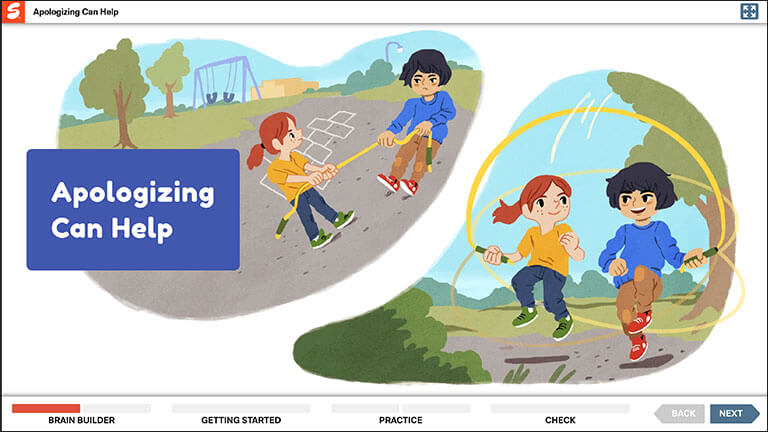
In this lesson, students will learn about apologizing as a way of showing kindness and as a tool for problem-solving in a variety of scenarios. Lesson Plan (PDF) Lesson Presentation
Lesson 9: Feeling Frustrated
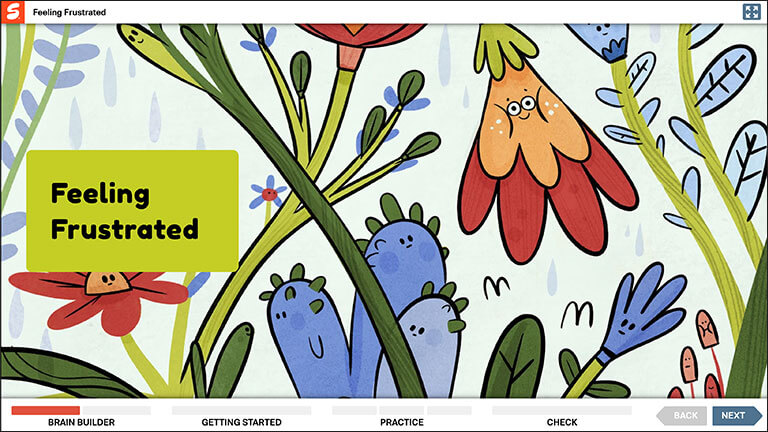
In this lesson, students will learn which clues tell them when others might be frustrated, and a new way to feel calm when they’re feeling frustrated themselves. Lesson Plan (PDF) Lesson Presentation
Lesson 16: The Way to Say a Problem
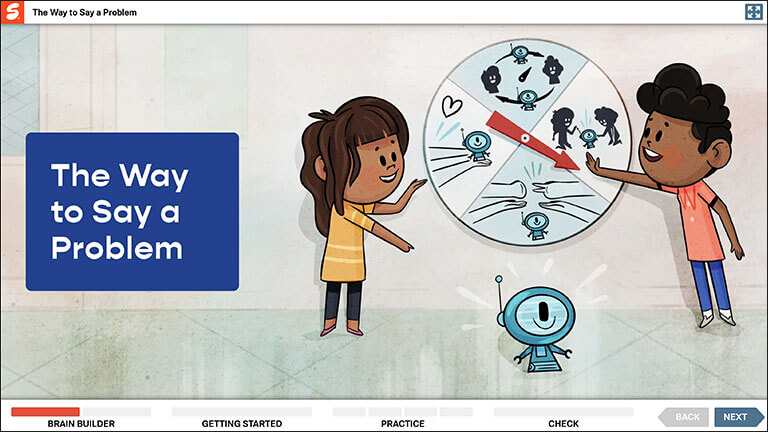
In this lesson, students will start learning to be better problem-solvers by managing strong feelings and stating problems without blame. Lesson Plan (PDF) Lesson Presentation Lesson Handout (PDF)
Lesson 14: Asking Questions

In this lesson, students will learn about asking questions to find out how someone else is feeling and to understand what their friends might want or need. Lesson Plan (PDF) Lesson Presentation Lesson Handout (PDF)
Lesson 17: Saying It Respectfully
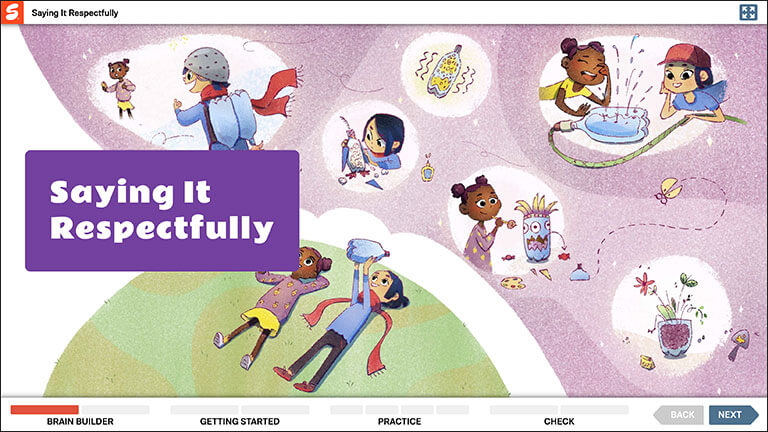
In this lesson, students will learn how to consider another person’s point of view and to say what they want or need in a respectful way. Lesson Plan (PDF) Lesson Presentation Lesson Handout A (PDF) Lesson Handout B (PDF)
Lesson 17: When? Where? Who?
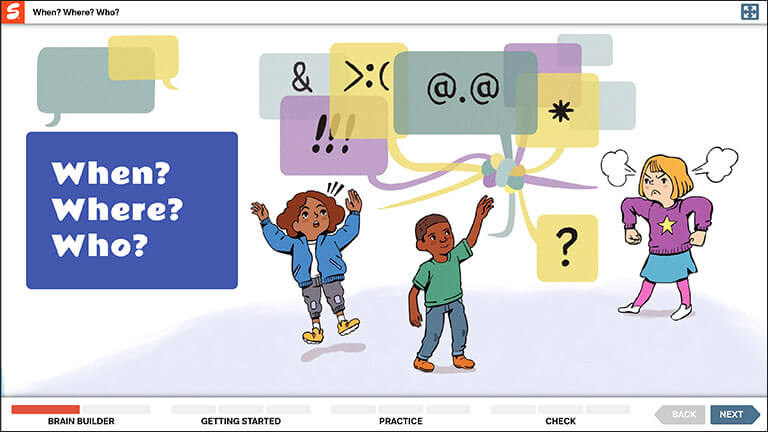
In this lesson, students will learn how to identify when and where to work on solving a problem, and who should be included. Lesson Plan (PDF) Lesson Presentation
Unit 4, Lesson 23: Respectful Communication
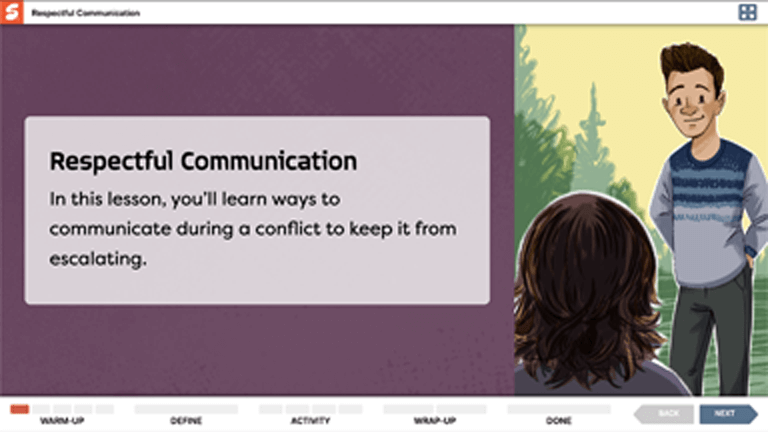
In this lesson, students will learn ways to communicate during a conflict to keep it from escalating through reflecting on their own experiences, defining respectful communication, and practicing using language that will help resolve conflicts. Sample This Lesson Lesson Plan (PDF) Student Handout (PDF)
Unit 3, Lesson 18: Practicing Positive Self-Talk
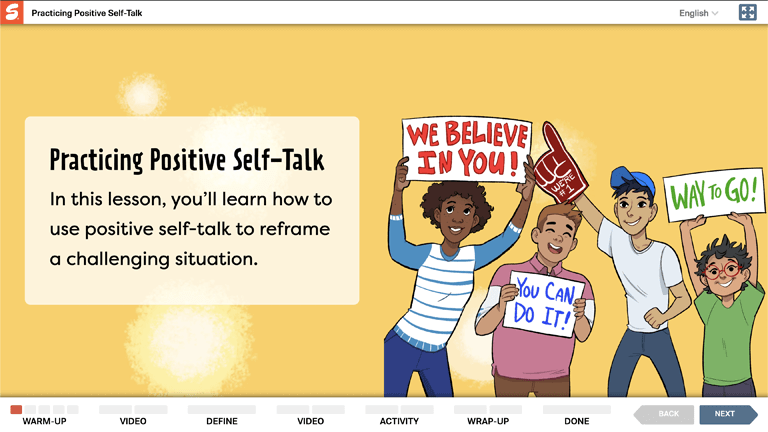
In this lesson, students will learn how to use positive self-talk to reframe challenging situations, including discussing why it isn’t always easy to see the positives and practicing noticing the positive things in their everyday lives. Sample This Lesson Lesson Plan (PDF) Student Handout (PDF)
Unit 2, Lesson 10: Environmental Factors that Contribute to Bullying
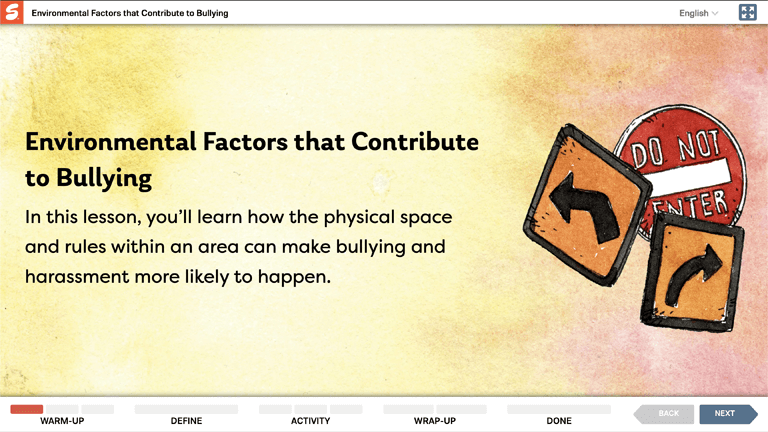
In this lesson, students will learn how the physical layout of and rules within a space can make bullying and harassment more likely to happen, from identifying environmental factors to discussing rules and regulations within their own school community. Sample This Lesson Lesson Plan (PDF) Student Handout (PDF)
Available for Early Learning through Grade 5 Explore samples from all grades below
Early Learning
Weekly Theme 6: Asking for What You Need or Want
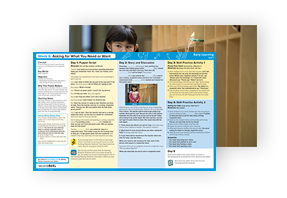
Weekly Theme Card

Take-Home Activity
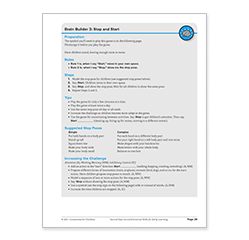
Brain Builder: Stop and Start
”How to Learn Song”

Listening Rules
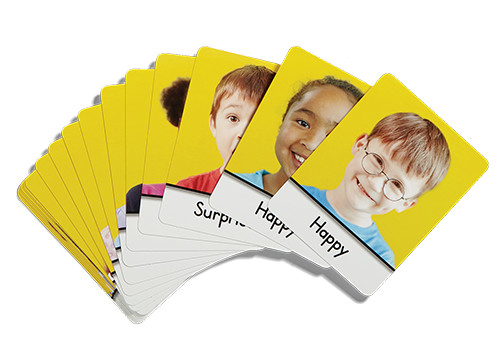
Feelings Cards
Lesson 2: Focusing Attention

Weekly Lesson Card
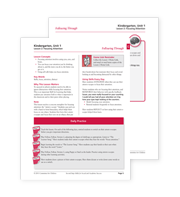
Following Through Card
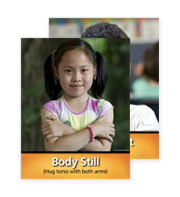
“The Learner Song”

Brain Builder: Follow, Follow

Skills for Learning Poster
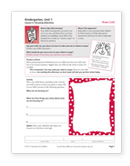
Lesson 11: Showing Care and Concern
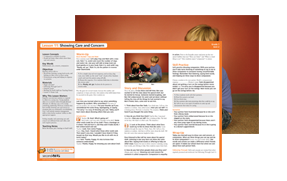
Brain Builder: Clap and Wait
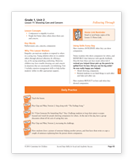
Empathy Poster
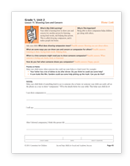
Lesson 17: Solving Problems, Part 1
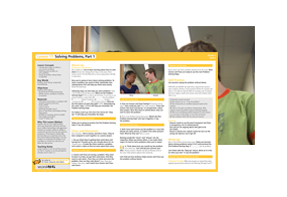
Skills for Learning
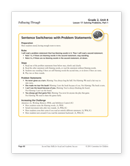
Brain Builder: Sentence Switcheroo

How to Calm Down Poster
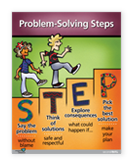
Problem-Solving Steps Poster
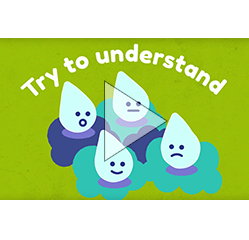
“The Empathy Song”

Problem Solving with Anthony
Lesson 8: Accepting Differences
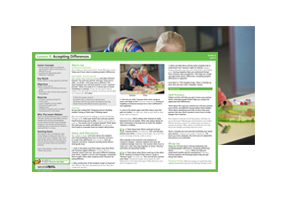
Brain Builder: Common Ground
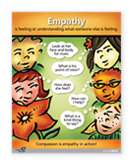
Student Handout
Lesson 15: Handling Put Downs
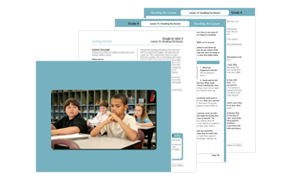
Teaching the Lesson Card
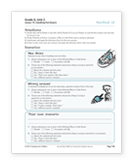
Lesson 15 Video (Parts 1 & 2)
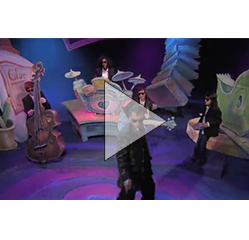
“Calm Down” Music Video
Lesson 21: Dealing with Peer Pressure
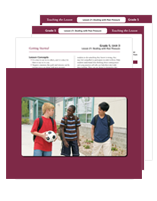
Lesson 21 Video (Parts 1, 2 & 3)

“Step Up” Music Video
Bullying Prevention Unit
Available for Kindergarten through Grade 5 Explore samples from Grades 2 and 5 below
Lesson 3: Refusing Bullying
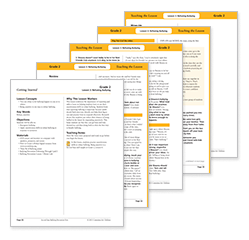
Lesson Samples
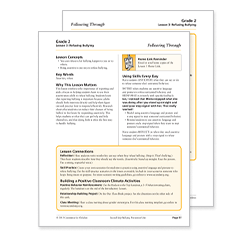
Classroom Activity
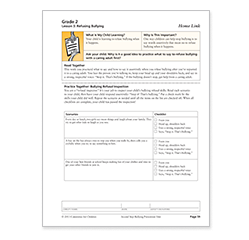
Addy’s Story
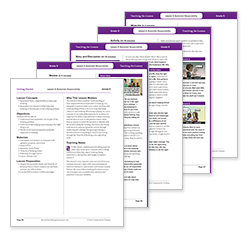
Noah and Olivia
Child Protection Unit
Available for Early Learning through Grade 5 Explore samples from Early Learning and Grades 2 and 5 below
Weekly Theme 3: Safe and Unsafe Touches

Weekly Theme Samples
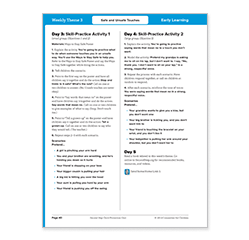
Ways to Stay Safe Poster
“The Safety Rules Song”
“Stop and Think”
Lesson 3: Safe and Unsafe Touches
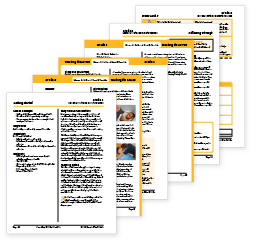
“Three Ways to Stay Safe”
Lesson 3: Unsafe and Unwanted Touches

“I’m in Charge” Music Video
Out-of-School Time
Available for Kindergarten through Grade 5 Explore samples from Kindergarten and Grade 1 below
Kindergarten–Grade 1
Unit 1, Topic 2: Facing Challenges with Confidence
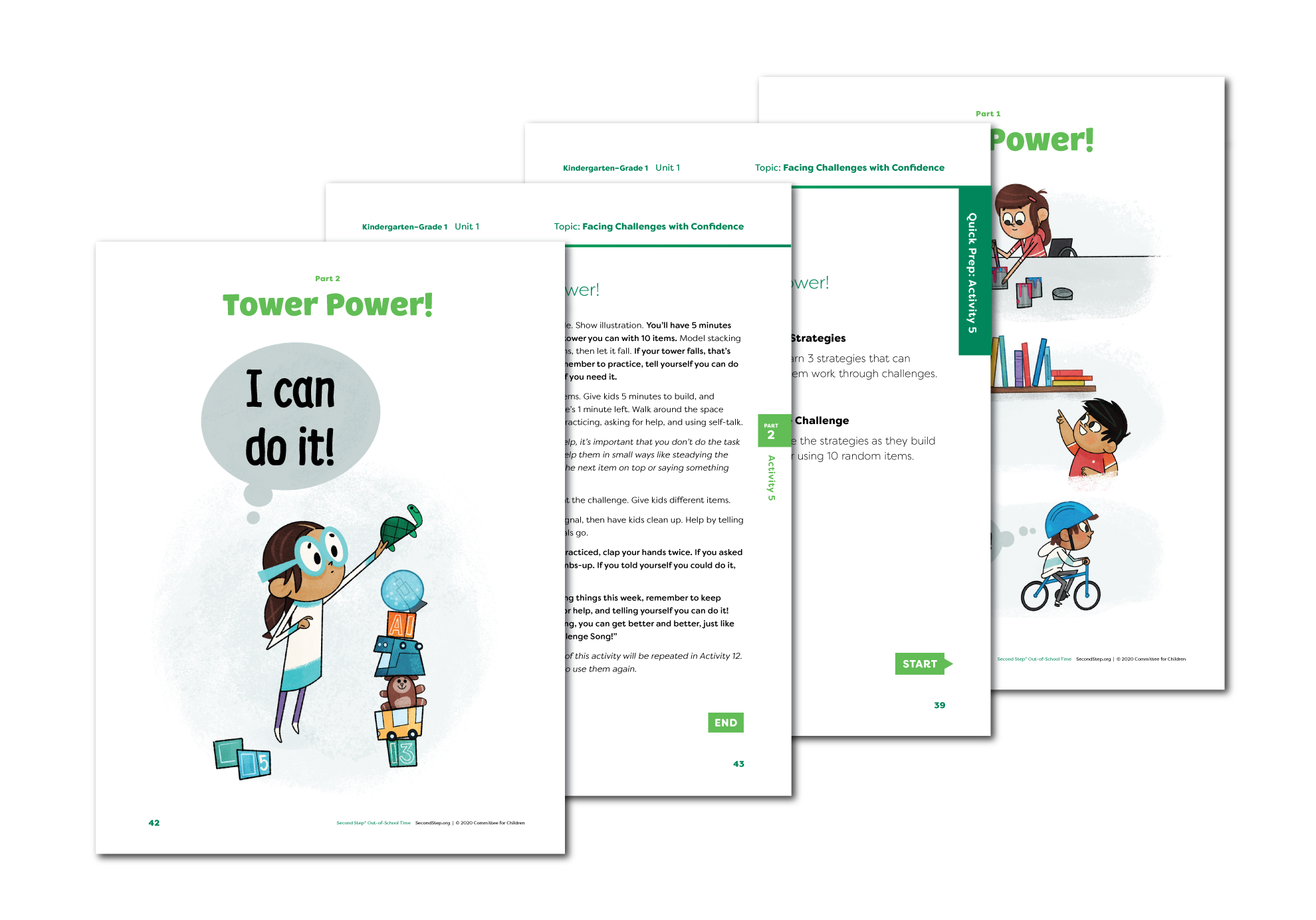
In this activity from the Growth Mindset & Goal Setting unit for Kindergarten–Grade 1, kids learn three strategies that can help them work through challenges and then use those strategies to build a tower from 10 random items.
Free Resources
Bullying Prevention Resources
Free Activities
Early, Open, Often
Abierto y a menudo
ParenTeen Connect
Your browser is not supported. Please upgrade your browser to one of our supported browsers . You can try viewing the page, but expect functionality to be broken.
Computer Science Fundamentals
Free set of elementary curricula that introduces students to the foundational concepts of computer science and challenges them to explore how computing and technology can impact the world.
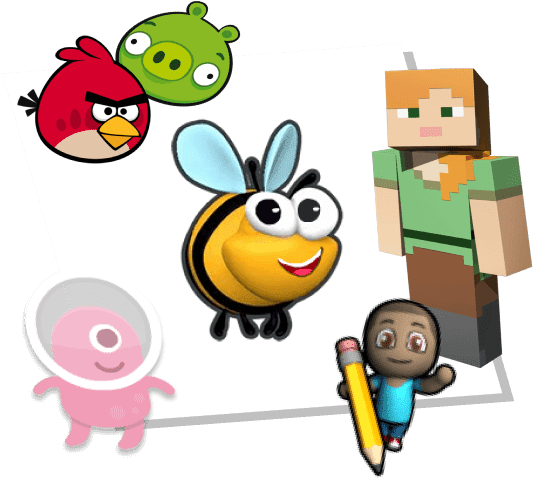
Free, and fun, elementary courses for each grade
- Six courses, one for each elementary grade
- Equitable introductory CS courses
- Use the same course for all students in the same grade, regardless of their experience
- All courses make suitable entry points for students
Curricula at a glance
Grades: K-5
Level: Beginner
Duration: Month or Quarter
Devices: Laptop, Chromebook, Tablet
Topics: Programming, Internet, Games and Animation, Art and Design, App Design
Programming Tools: Sprite Lab, Play Lab
Professional Learning: Facilitator-led Workshops, Self-paced Modules
Accessibility: Text-to-speech, Closed captioning, Immersive reader
Languages Supported: Arabic, Bahasa Indonesian, Catalán, Chinese Simplified, Chinese Traditional, Czech, French, German, Hindi, Italian, Japanese, Korean, Kannada, Malay, Marathi, Mongolian, Polish, Portuguese-BR, Romanian, Russian, Slovak, Tagalog, Tamil, Thai, Turkish, Ukrainian, Spanish Latam, Urdu, Spanish-ES, Uzbek, Vietnamese
I've been teaching the course since the Monday after the workshop. The students and I LOVE it (and so do their classroom teachers!!!)
CS Fundamentals Teacher
Picking the right CS Fundamentals course for your classroom
With the diverse set of options offered for CS Fundamentals, there is a course for all different needs.
How will your students engage with the content?
Courses specifically designed for your elementary classroom.
Find the course for the grade you teach. Each course is approximately a month long.
Kindergarten

Program using commands like loops and events. Teach students to collaborate with others, investigate different problem-solving techniques, persist in the face of challenging tasks, and learn about internet safety.
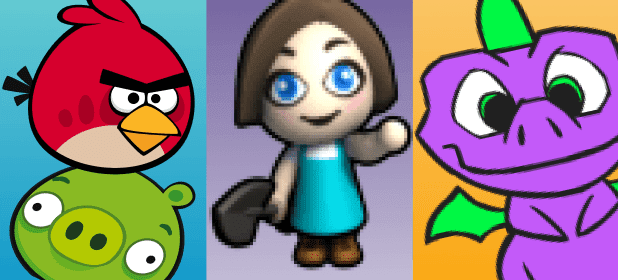
Through unplugged activities and a variety of puzzles, students will learn the basics of programming, collaboration techniques, investigation and critical thinking skills, persistence in the face of difficulty, and internet safety.
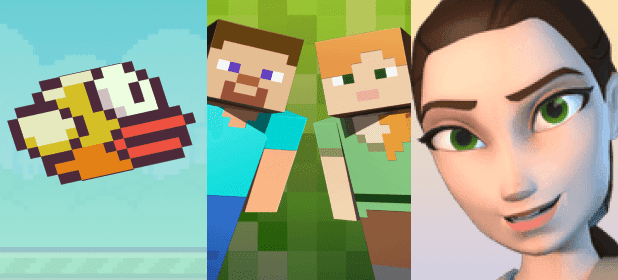
Create programs with sequencing, loops, and events. Investigate problem-solving techniques and develop strategies for building positive communities both online and offline. Create interactive games that students can share.

Review of the concepts found in earlier courses, including loops and events. Afterward, students will develop their understanding of algorithms, nested loops, while loops, conditionals, and more.

Make fun, interactive projects that reinforce learning about online safety. Engage in more complex coding such as nested loops, functions, and conditionals.

Look at how users make choices in the apps they use. Make a variety of Sprite Lab apps that also offer choices for the user. Learn more advanced concepts, including variables and “for” loops.
Self-paced elementary curriculums
Teachers play a critical role in student learning by teaching our unplugged activities and leading whole class discussions, however, we recognize that CS Fundamentals isn't always taught in a traditional classroom setting. We provide two self-paced express courses alongside Courses A-F. These express courses are designed for situations where teachers allow each student to work at their own pace independently.
Grades: K-1
Pre-Reader Express

Learn the basics of drag-and-drop block coding by solving puzzles and creating animated scenes. Make art and simple games to share with friends, family, and teachers.
Grades: 2-5
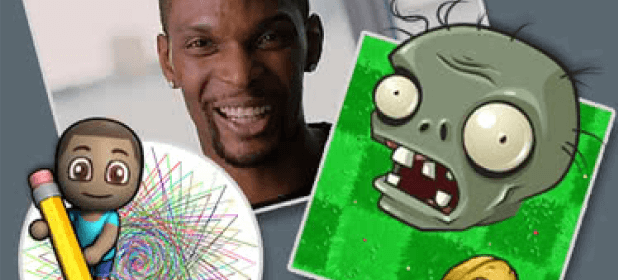
Learn to create computer programs, develop problem-solving skills, and work through fun challenges! Make games and creative projects to share with friends, family, and teachers.
No devices? We have you covered
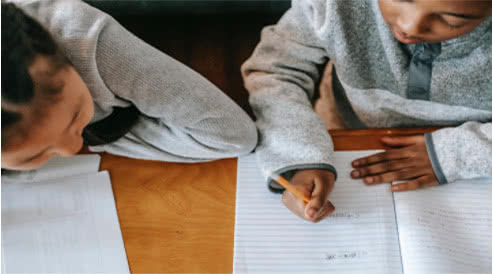
Go ahead, cut the cord (for a while)!
CS education does not always need to be in front of a screen and device access shouldn't be a barrier to learning computer science concepts.
Resources that support you every step of the way
Sign up for a Code.org account to get access to materials that will help you teach computer science with confidence. Code.org has extensive resources designed to support educators, even those without prior CS teaching experience.
Lesson Plans
Get step-by-step guidance, learning objectives, and assessment strategies for effective teaching.
Helpful resources include slide decks, activity guides, rubrics, and more — all organized in one place. Each lesson plan is accompanied by tips for classroom implementation, differentiation ideas, and extension activities to cater to students of all abilities.
Instructional Videos
Watch easy-to-understand overviews of computer science and programming concepts.
Code.org video series are designed specifically to support your classroom and are engaging and fun to watch.
Slide Decks
We offer educators an organized, visually engaging, and pedagogically sound framework to deliver computer science lessons.
Code.org slide decks provide step-by-step instructions, examples, and interactive activities that align with curricular objectives.

Assessments
Our curricula includes a comprehensive system of formative and summative assessment resources.
These include rubrics, checklists, mini-projects, end-of-chapter projects, student-facing rubrics, sample projects, and post-project tests — all designed to support teachers in measuring student growth, providing feedback, and evaluating student understanding.
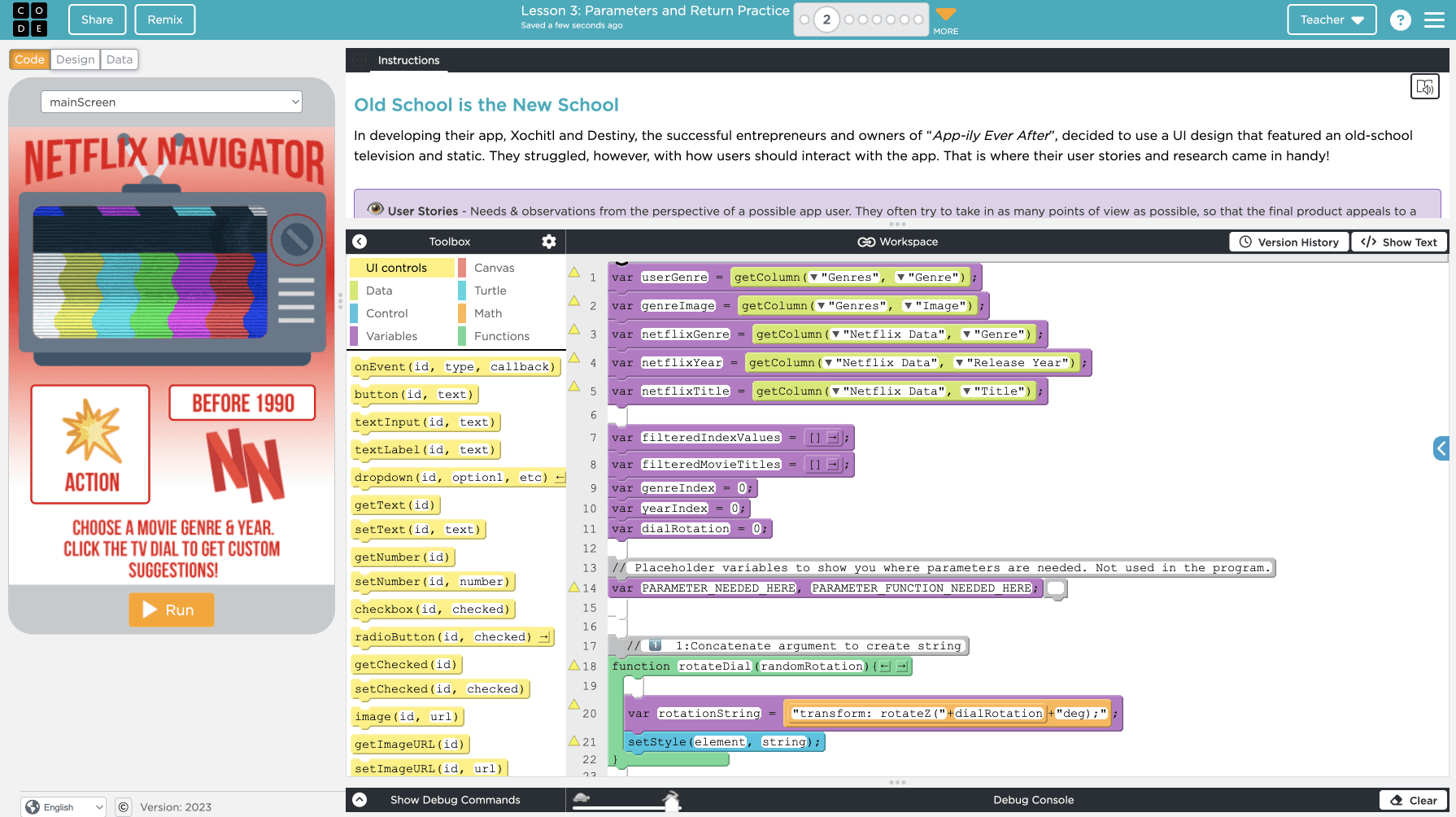
Programming Tools
Code.org's integrated development environments (IDEs) cater to students of all skill levels.
We offer a versatile and user-friendly platform that supports a variety of programming paradigms. This enables learners to seamlessly transition from block-based coding to text-based languages, and fosters creativity and innovation.
Professional learning that meets your needs
Get the support you need as you prepare to teach. Teachers love it, with over 90% ranking it the best professional development ever!
Facilitator-led Workshops
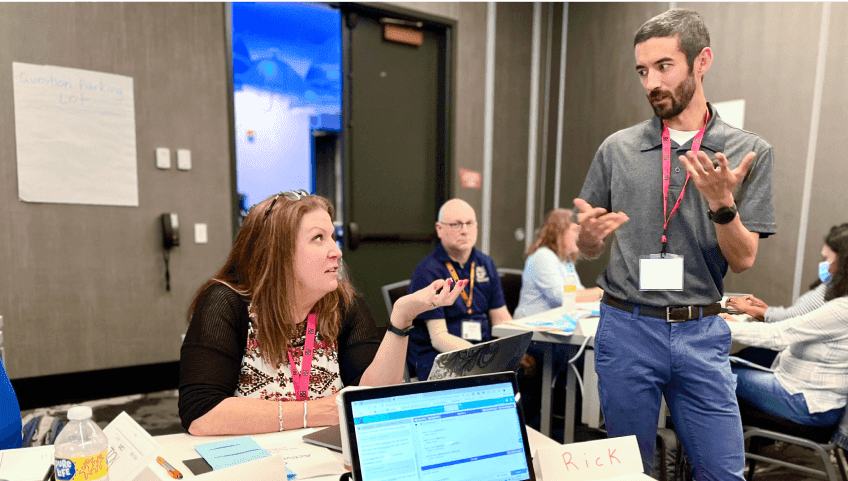
Join local teachers for inspiring and hands-on support to implement computer science in your classroom. Our Regional Partners offer high-quality, one-day Code.org workshops for individual teachers or for schoolwide PD. Sign up for a professional development workshop near you!
Self-Paced Online Modules

Through reading, viewing videos, completing interactive puzzles, and reflecting on your learning, you will develop your own understanding while preparing to teach computer science in your classroom.
Frequently asked questions
CS Fundamentals was written using both the K-12 Framework for Computer Science and the CSTA standards as guidance. Currently, every lesson in CS Fundamentals contains mappings to the relevant CSTA standards. The summary of all CSTA mappings for each course can be found at:
- Course A Standards
- Course B Standards
- Course C Standards
- Course D Standards
- Course E Standards
- Course F Standards
A Google Sheets version of the standards can be found at CSF Standards .
The leading K-12 CS curriculum in the United States, our elementary program has been proven effective in major urban school districts like Dallas, as well as small rural districts in Iowa. There is no need to hire specialists to teach CS. Our program is uniquely designed to support teachers new to CS while offering the flexibility to evolve lessons to fit student needs. Share this brochure with your school and district administrators, or suggest they take a look at our administrators page specially designed to answer administrators' most common questions.
Our curriculum and platform are available at no cost for anyone, anywhere, to teach!
New to teaching computer science? No worries! Most of our teachers have never taught computer science before. Join local teachers for inspiring and hands-on support to implement computer science in your classroom. Our Regional Partners offer high-quality, one-day Code.org workshops for individual teachers or for schoolwide PD. Sign up for a professional development workshop near you !
Join over 100,000 teachers who have participated in our workshops. The majority of our workshop attendees say, 'It's the best professional development I've ever attended.' In fact, 90% of attendees would recommend our program to other teachers !
Each CSF course includes 13-17 lessons designed for 45-minute periods. We recommend all students move from lesson to lesson at a pace set by the teacher. There are many teacher-led project levels designed to be experienced in unison while the skill-building lessons can be completed by students at their own pace.
Many lessons have handouts that guide students through activities. These resources can be printed or assigned digitally. Some lessons call for typical classroom supplies and manipulatives. Visit the CSF Syllabus to learn more .
Support and questions

Still have questions? Reach out to us! We are here to help.
Our support team is here to answer any questions you may have about starting teaching with Code.org. You can also ask other teachers about their experience on our teacher forums.
Subscribe for updates
Sign up to receive monthly emails about Code.org's Computer Science Fundamentals and get helpful reminders, tips, and updates sent right to your inbox.
You can unsubscribe at any time.
Please select your language

- Share on Facebook
- Tweet This Resource
- Pin This Resource

Problem Solving Process: One-To-One Correspondence
First graders observe and demonstrate a variety of problem solving strategies to solve problems involving one-to-one correspondence and whole numbers to 100. They discuss the steps of the problem solving process, and solve a word problem step-by-step with the teacher.
Start Your Free Trial
Save time and discover engaging curriculum for your classroom. Reviewed and rated by trusted, credentialed teachers.
- Collection Types
- Activities & Projects
- Assessments
- Graphics & Images
- Handouts & References
- Interactives
- Lab Resources
- Learning Games
- Lesson Plans
- Presentations
- Primary Sources
- Printables & Templates
- Professional Documents
- Study Guides
- Instructional Videos
- Performance Tasks
- Graphic Organizers
- Writing Prompts
- Constructed Response Items
- AP Test Preps
- Lesson Planet Articles
- Online Courses
- Interactive Whiteboards
- Home Letters
- Unknown Types
- Stock Footages
- All Resource Types
See similar resources:
Activities that build number sense, number flash cards 1 to 10, mixed addition and subtraction year 1, earth day number practice 0-20, how i get to school, missing number game, use a number line to add, count to 10 song - rockin' english lesson (numbers 1-10), "count to 20 song" - rockin' english musical lesson (numbers 1-20).
Chapter 1, Lesson 1: A Plan for Problem Solving
- Extra Examples
- Group Activity Cards
- Personal Tutor
- Self-Check Quizzes
The resource you requested requires you to enter a username and password below:
Please read our Terms of Use and Privacy Notice before you explore our Web site. To report a technical problem with this Web site, please contact the site producer .


IMAGES
VIDEO
COMMENTS
Identifying the problem the character (s) is experiencing in the beginning of the story. Asking questions and making predictions about possible upcoming events and about possible ways to solve the problem. Understanding how the events and characters influence the problem throughout the story. Describing the solution includes: Confirming or ...
Introduction. (10 minutes) Bring students together in a circle, either seated or standing. Bring blocks with you to the circle. Show the student the blocks and ask them to watch you build a tall castle. After you build it, bring out two figurines that you would like to play with in the castle. Say out loud, "Hmm....there seems to be a problem.
Solving Word Problems (Grades 1-2) Our Solving Word Problems lesson plan provides students with strategies to help them solve word problems, such as using illustrations or drawings. Students practice solving example word problems using the given strategies. Our Solving Word Problems lesson plan develops math problem-solving strategies for young ...
This Problem Solving lesson plan also includes: Project. Vocabulary. Join to access all included materials. First graders explore problems and solutions. In this math instructional activity, 1st graders brainstorm problems they have encountered and how they solved them. Then students watch a video about how professionals solve problems.
Common Core Standard(s): 1.OA.1 Use addition and subtraction within 20 to solve word problems involving situations of adding to, taking from, putting together, taking apart, and comparing, with unknowns in all positions, e.g., by using objects, drawings and equations with a symbol for the unknown number to represent the problem.
Define the word problem in student's home language (L1) if student is literate in home language. Provide an example of a simplified story problem. Intermediate. Encourage students to repeat the story problem back to you, in their own words. Ask students to explain what a problem is in their own words. Write the standard algorithm ( 1 + 11 + 6 ...
Sharing 5 fun and engaging math lessons to give you a better idea of the structure and format of our grade 1 math lesson plans: Dive into Subitizing. 2-Digit Place Value Adventure. Addition & Subtraction Problems Magic. Length Adventures: Dive into Measurement Fun.
More Lessons for Grade 1. Common Core for Grade 1. Solve word problems that call for addition of three whole numbers whose sum is less than or equal to 20, e.g., by using objects, drawings, and equations with a symbol for the unknown number to represent the problem. Common Core: 1.OA.1 and 1.OA.2.
TPT. Marketplace for millions of educator-created resources. Browse 1st Grade Subtraction Word Problem Lesson Plans. Award winning educational materials designed to help kids succeed. Start for free now!
In order to implement a problem-based instruction lesson in your classroom, there are a few planning steps to consider. Fill in the blanks with your lesson-specific information in order to plan your problem-based lesson. 1. Develop clear and measurable learning objectives (including cognitive and behavioral objectives) - based on Bloom's ...
This Problem Solving Lesson Plan is suitable for 1st Grade. First graders tell stories in an add and subtract form. They write out the problems using symbols. ... Discover Resources Search reviewed educational resources by keyword, subject, grade, type, and more Curriculum Manager ...
These grade 1 word problem worksheets relate first grade math concepts to the real world. The word problems cover addition, subtraction, time, money, fractions and lengths. We encourage students to think about the problems carefully by: providing a number of mixed word problem worksheets; sometimes including irrelevant data within word problems.
1-PS4-1 . Plan and conduct investigations to provide evidence that vibrating materials can make sound and that sound can make materials vibrate. Nature is full of objects with many different shapes. Some of these shapes display obvious regularities or distinct patterns, such as stripes, waves, symmetry, or spirals.
Lesson plan. (60 -75 minutes) This lesson is designed to equip young people with an adaptable approach to solving problems, large or small. It includes a short film and scenarios that encourage development of practical problem solving skills which can be useful for learning, day to day life, and when in employment.
Browse 1st grade lesson plans for math and ELA, much loved by teachers and students! Find standards-aligned plans to ease teaching preparation. Start for free! Parents. Educators ... Unleash your problem-solving skills with this interactive math lesson on addition word problems. Solve mysteries while mastering the count on strategy! 1. VIEW ...
Grade 6. Unit 4, Lesson 23: Respectful Communication. In this lesson, students will learn ways to communicate during a conflict to keep it from escalating through reflecting on their own experiences, defining respectful communication, and practicing using language that will help resolve conflicts. Sample This Lesson. Lesson Plan (PDF)
Choose students to describe what is known: 1) There were eight tulips. 2) There were two roses. Call on students to share different approaches to solve the problem. Rephrase student thinking and strategies as needed. Download to read more. Use this fun collaborative math lesson to help your students learn all about different problem solving ...
Overcoming Obstacles is a free, award-winning, and research-based K-12 curriculum that provides you with the tools to teach your students life skills. With hundreds of activity-based lessons covering more than 30 skills, students learn how to communicate effectively. They learn how to make informed decisions.
This relatable story is perfect for calming nerves before a big test! Designed for first -third grade students, this comprehensive lesson plan is full of engaging opportunities for discussing problem and solution. This download is loaded with options to customize for the perfect-fit lesson for your students.
Free, and fun, elementary courses for each grade. Six courses, one for each elementary grade; Equitable introductory CS courses; ... investigate different problem-solving techniques, persist in the face of challenging tasks, and learn about internet safety. See course details Grade 1. Course B. ... Lesson Plans. Get step-by-step guidance ...
Find problem and solution stories for grade 1 lesson plans and teaching resources. Quickly find that inspire student learning. ... Learners categorize information into a problem/solving chart and examine the value of using a diary. In this problem solving and diary lesson plan, students read portions of Dear Mr. Henshaw, while they investigate ...
Problem Solving Lesson Plan. Problems come in all shapes and sizes, and so do solutions. Help your students learn different problem solving methods using this engaging video based lesson plan ...
This Problem Solving Process: One-To-One Correspondence Lesson Plan is suitable for 1st Grade. First graders observe and demonstrate a variety of problem solving strategies to solve problems involving one-to-one correspondence and whole numbers to 100. They discuss the steps of the problem solving process, and solve a word problem step-by-step with the teacher.
Lesson Resources Extra Examples Group Activity Cards Personal Tutor Self-Check Quizzes. ... Mathematics. Home > Chapter 1 > Lesson 1. California Mathematics: Concepts, Skills, and Problem Solving, Grade 6. Chapter 1, Lesson 1: A Plan for Problem Solving. Extra Examples; Group Activity Cards; Personal Tutor; Self-Check Quizzes;
Problem-based Learning (PBL) is widely used in teaching mathematics in Thailand. However, Situation-based Learning (SBL) is rare in mathematics education literature in Thailand. The combination of PBL with SBL will bring students to learning through solving the problem dealt with the situation being relevant to students' real lives. In the high technology world of 21st century, teachers are ...